sensor HONDA CR-Z 2015 1.G Owners Manual
[x] Cancel search | Manufacturer: HONDA, Model Year: 2015, Model line: CR-Z, Model: HONDA CR-Z 2015 1.GPages: 329, PDF Size: 17.44 MB
Page 31 of 329
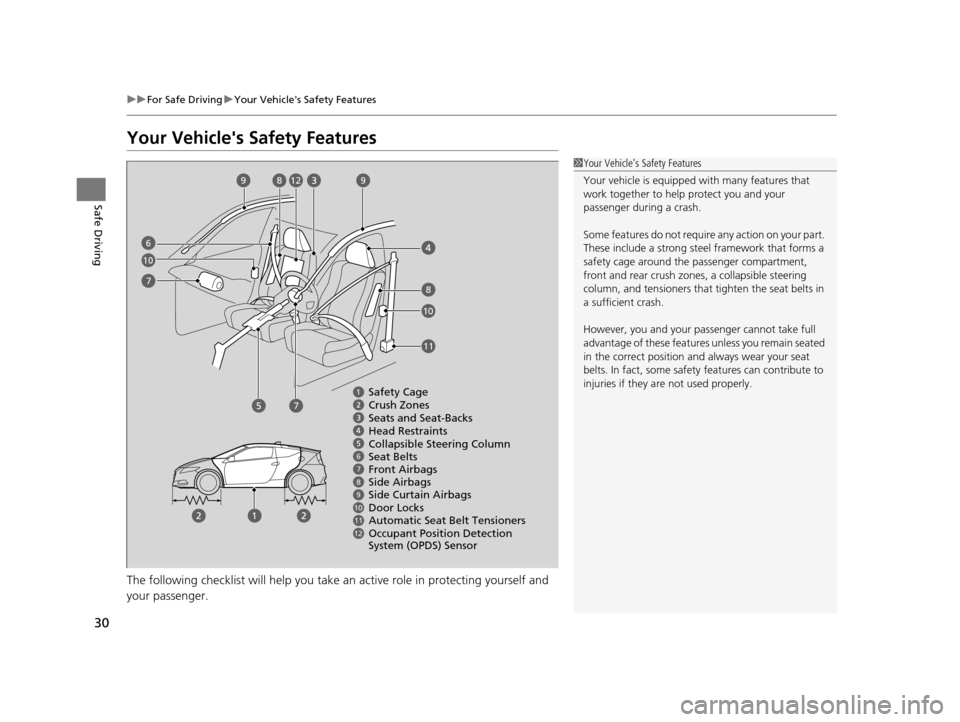
30
uuFor Safe Driving uYour Vehicle's Safety Features
Safe Driving
Your Vehicle's Safety Features
The following checklist will help you take an active role in protecting yourself and
your passenger.
1 Your Vehicle's Safety Features
Your vehicle is equipped wi th many features that
work together to help protect you and your
passenger dur ing a crash.
Some features do not require any action on your part.
These include a strong steel framework that forms a
safety cage around the passenger compartment,
front and rear crush zones, a collapsi ble steering
column, and tensioners that tighten the seat belts in
a sufficient crash.
However, you and your passenger cannot take full
advantage of these features unless you remain seated
in the correct position and always wear your seat
belts. In fact, some safety features can contribute to
injuries if they are not used properly.
6
7
89
10
11
12
7
8
9
10
678910
12
Safety Cage
Crush Zones
Seats and Seat-Backs
Head Restraints
Collapsible Steering Column
Seat Belts
Front Airbags
Side Curtain Airbags
Door Locks
Occupant Position Detection
System (OPDS) Sensor Side Airbags
11Automatic Seat Belt Tensioners
15 CR-Z-31SZT6400.book 30 ページ 2014年8月1日 金曜日 午後1時59分
Page 34 of 329
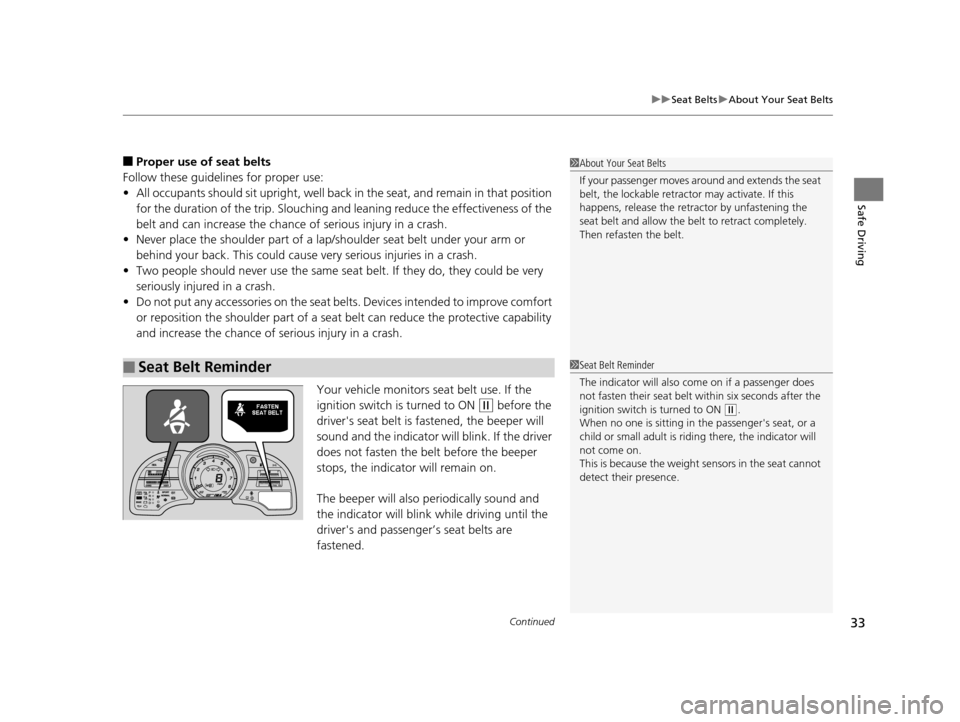
Continued33
uuSeat Belts uAbout Your Seat Belts
Safe Driving
■Proper use of seat belts
Follow these guidelines for proper use:
• All occupants should sit upright, well back in the seat, and remain in that position
for the duration of the trip. Slouching and leaning reduc e the effectiveness of the
belt and can increase the chance of serious injury in a crash.
• Never place the shoulder part of a lap/shoulder seat belt under your arm or
behind your back. This could cause very serious injuries in a crash.
• Two people should never use the same seat belt. If they do, they could be very
seriously injured in a crash.
• Do not put any accessories on the seat belt s. Devices intended to improve comfort
or reposition the shoulder part of a seat belt can reduce the protective capability
and increase the chance of serious injury in a crash.
Your vehicle monitors seat belt use. If the
ignition switch is turned to ON
(w before the
driver's seat belt is fastened, the beeper will
sound and the indicator will blink. If the driver
does not fasten the belt before the beeper
stops, the indicato r will remain on.
The beeper will also periodically sound and
the indicator will blink while driving until the
driver's and passenger’s seat belts are
fastened.
■Seat Belt Reminder
1 About Your Seat Belts
If your passenger moves around and extends the seat
belt, the lockable retractor may activate. If this
happens, release the retractor by unfastening the
seat belt and allow the belt to retract completely.
Then refasten the belt.
1Seat Belt Reminder
The indicator will also co me on if a passenger does
not fasten their seat belt within six seconds after the
ignition switch is turned to ON
( w.
When no one is sitting in th e passenger's seat, or a
child or small adult is ridi ng there, the indicator will
not come on.
This is because the weight sensors in the seat cannot
detect their presence.
READY
15 CR-Z-31SZT6400.book 33 ページ 2014年8月1日 金曜日 午後1時59分
Page 41 of 329
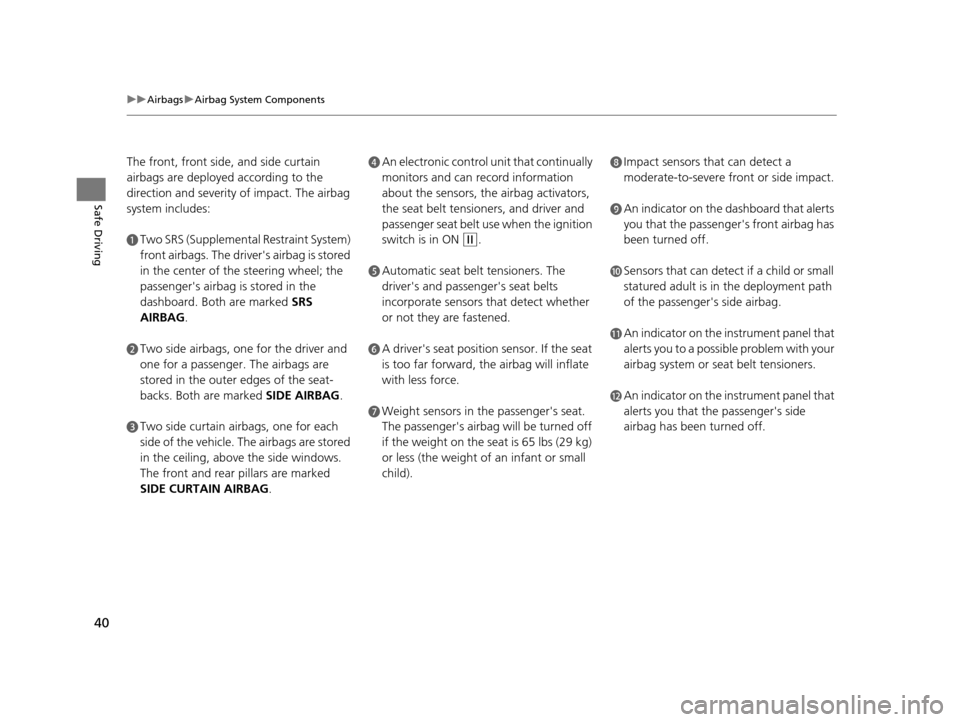
40
uuAirbags uAirbag System Components
Safe Driving
The front, front side, and side curtain
airbags are deployed according to the
direction and severity of impact. The airbag
system includes:
aTwo SRS (Supplemental Restraint System)
front airbags. The driver's airbag is stored
in the center of the steering wheel; the
passenger's airbag is stored in the
dashboard. Both are marked SRS
AIRBAG.
bTwo side airbags, one for the driver and
one for a passenger. The airbags are
stored in the outer edges of the seat-
backs. Both are marked SIDE AIRBAG .
cTwo side curtain airbags, one for each
side of the vehicle. The airbags are stored
in the ceiling, above the side windows.
The front and rear pillars are marked
SIDE CURTAIN AIRBAG.
dAn electronic control unit that continually
monitors and can re cord information
about the sensors, the airbag activators,
the seat belt tensioners, and driver and
passenger seat belt use when the ignition
switch is in ON
(w.
eAutomatic seat belt tensioners. The
driver's and passenger's seat belts
incorporate sensors that detect whether
or not they are fastened.
fA driver's seat position sensor. If the seat
is too far forward, the airbag will inflate
with less force.
gWeight sensors in the passenger's seat.
The passenger's airbag will be turned off
if the weight on the seat is 65 lbs (29 kg)
or less (the weight of an infant or small
child).
hImpact sensors that can detect a
moderate-to-severe front or side impact.
iAn indicator on the dashboard that alerts
you that the passenger's front airbag has
been turned off.
jSensors that can detect if a child or small
statured adult is in the deployment path
of the passenger's side airbag.
kAn indicator on the instrument panel that
alerts you to a possible problem with your
airbag system or seat belt tensioners.
lAn indicator on the instrument panel that
alerts you that the passenger's side
airbag has been turned off.
15 CR-Z-31SZT6400.book 40 ページ 2014年8月1日 金曜日 午後1時59分
Page 44 of 329

Continued43
uuAirbags uFront Airbags (SRS)
Safe DrivingFront airbags are designed to inflate duri ng moderate-to-severe frontal collisions.
When the vehicle decelerates suddenly, the sensors send information to the control
unit which signals one or both front airbags to inflate.
A frontal collision can be either head-on or angled between two vehicles, or when a
vehicle crashes into a stationary object, such as a concrete wall.
While your seat belt restrains your torso, the
front airbag provides supplemental protection
for your head and chest.
The front airbags deflate immediately so that
they won't interfere with the driver's visibility
or the ability to steer or operate other
controls.
The total time for inflation and deflation is so fast that most occupants are not
aware that the airbags deployed until th ey see them lying in front of them.
■Operation
■How the Front Airbags Work1How the Front Airbags Work
Although the driver's a nd passenger's airbags
normally inflate within a spli t second of each other, it
is possible for only one airbag to deploy. This can
happen if the severity of a collision is at the margin,
or threshold, that determines whether or not the
airbags will deploy. In such cases, the seat belt will
provide sufficient protec tion, and the supplemental
protection offered by the airbag would be minimal.
15 CR-Z-31SZT6400.book 43 ページ 2014年8月1日 金曜日 午後1時59分
Page 45 of 329
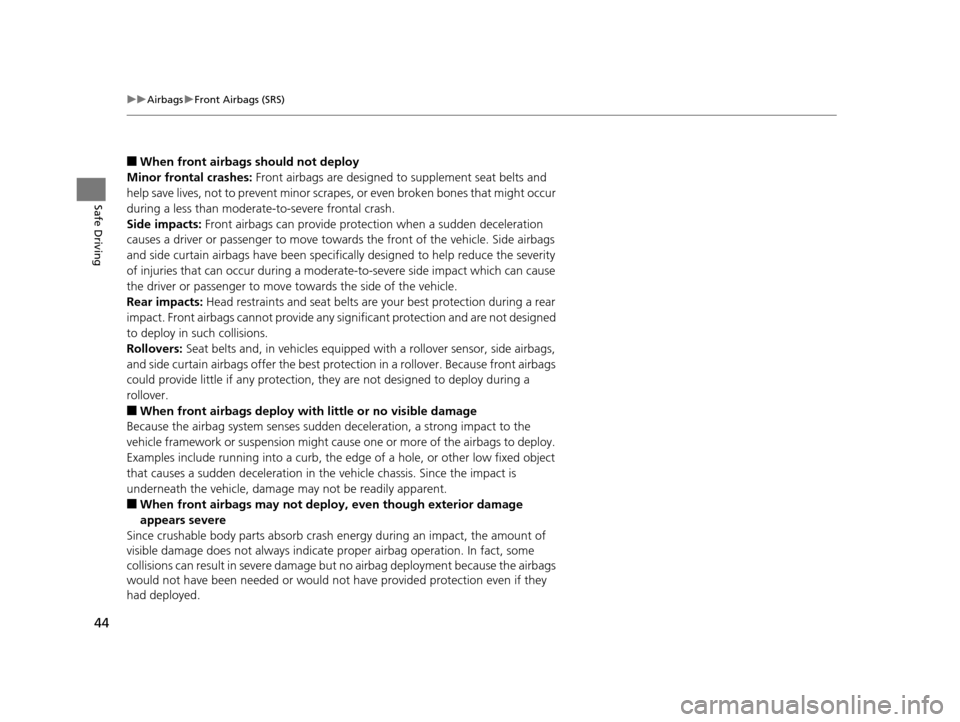
44
uuAirbags uFront Airbags (SRS)
Safe Driving
■When front airbags should not deploy
Minor frontal crashes: Front airbags are designed to supplement seat belts and
help save lives, not to prevent minor scrapes, or even broken bones that might occur
during a less than moderate-to-severe frontal crash.
Side impacts: Front airbags can provide protection when a sudden deceleration
causes a driver or passenger to move towa rds the front of the vehicle. Side airbags
and side curtain airbags have been specifically designed to help reduce the severity
of injuries that can occur during a moderate-to-severe side impact which can cause
the driver or passenger to move towards the side of the vehicle.
Rear impacts: Head restraints and seat belts are your best protection during a rear
impact. Front airbags cannot provide any si gnificant protection and are not designed
to deploy in such collisions.
Rollovers: Seat belts and, in vehicles equipped with a rollover sensor, side airbags,
and side curtain airbags offer the best prot ection in a rollover. Because front airbags
could provide little if any protection, they are not designed to deploy during a
rollover.
■When front airbags deploy with little or no visible damage
Because the airbag system senses sudden deceleration, a strong impact to the
vehicle framework or suspension might caus e one or more of the airbags to deploy.
Examples include running into a curb, the edge of a hole, or other low fixed object
that causes a sudden deceleration in th e vehicle chassis. Since the impact is
underneath the vehicle, damage may not be readily apparent.
■When front airbags may not deploy , even though exterior damage
appears severe
Since crushable body parts absorb crash energy during an impact, the amount of
visible damage does not always indicate proper airbag operation. In fact, some
collisions can result in severe damage but no airbag deployment because the airbags
would not have been needed or would not have provided protection even if they
had deployed.
15 CR-Z-31SZT6400.book 44 ページ 2014年8月1日 金曜日 午後1時59分
Page 46 of 329
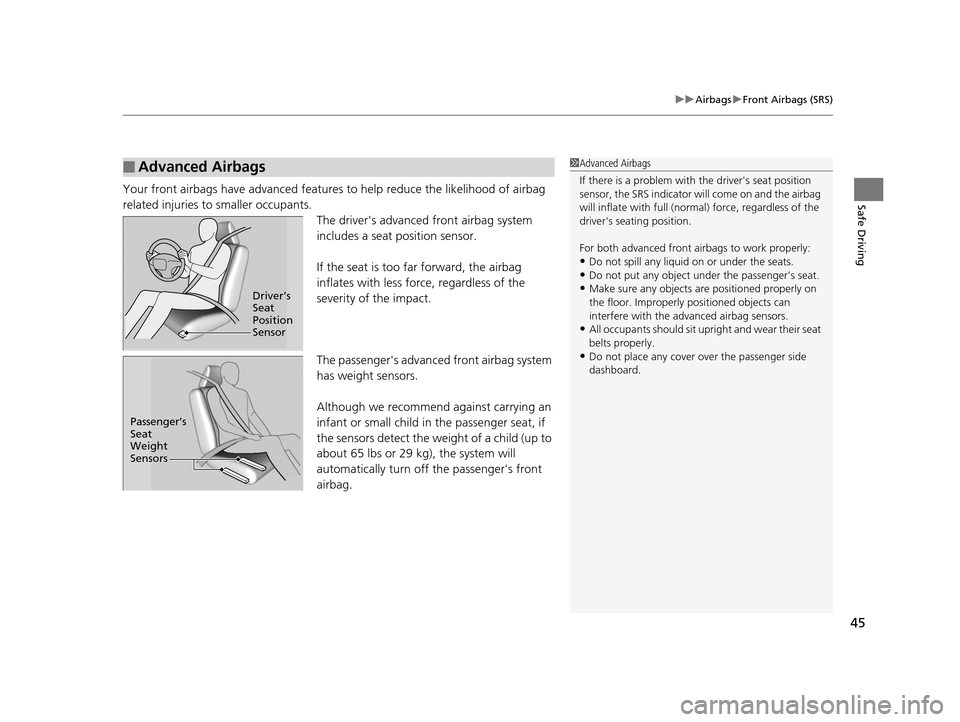
45
uuAirbags uFront Airbags (SRS)
Safe DrivingYour front airbags have advanced features to help reduce the likelihood of airbag
related injuries to smaller occupants.
The driver's advanced front airbag system
includes a seat position sensor.
If the seat is too far forward, the airbag
inflates with less force, regardless of the
severity of the impact.
The passenger's advanced front airbag system
has weight sensors.
Although we recommend against carrying an
infant or small child in the passenger seat, if
the sensors detect the weight of a child (up to
about 65 lbs or 29 kg), the system will
automatically turn off the passenger's front
airbag.
■Advanced Airbags1 Advanced Airbags
If there is a problem with the driver's seat position
sensor, the SRS indicator wi ll come on and the airbag
will inflate with full (normal) force, regardless of the
driver's seating position.
For both advanced front airbags to work properly:
•Do not spill any liquid on or under the seats.•Do not put any object under the passenger’s seat.
•Make sure any objects are positioned properly on
the floor. Improperly pos itioned objects can
interfere with the advanced airbag sensors.
•All occupants should sit upri ght and wear their seat
belts properly.
•Do not place any cover over the passenger side
dashboard.
Driver’s
Seat
Position
Sensor
Passenger’s
Seat
Weight
Sensors
15 CR-Z-31SZT6400.book 45 ページ 2014年8月1日 金曜日 午後1時59分
Page 47 of 329
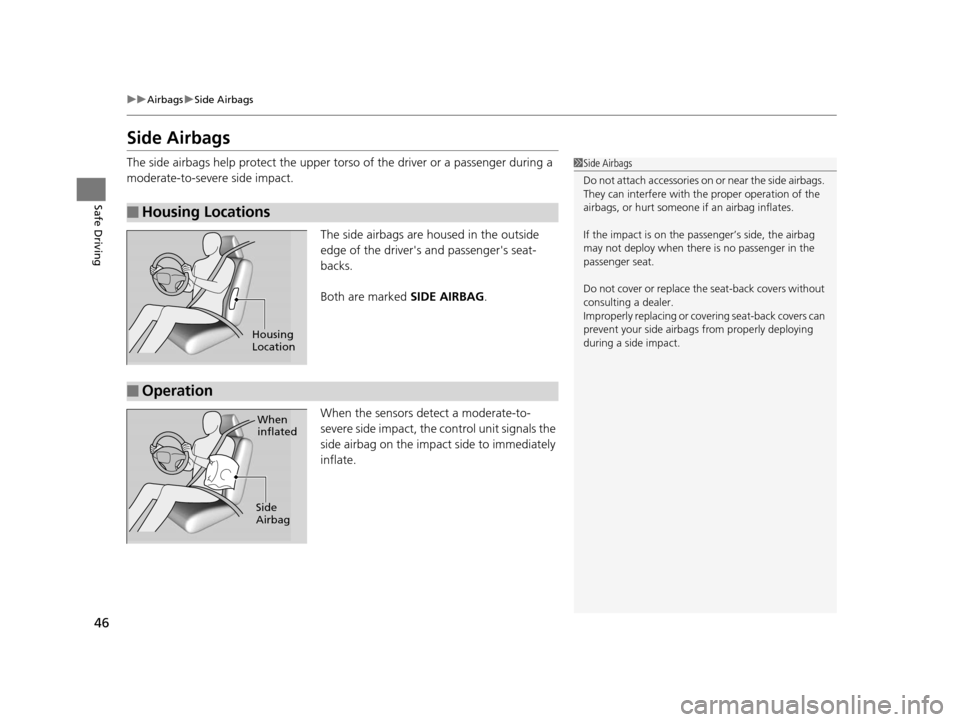
46
uuAirbags uSide Airbags
Safe Driving
Side Airbags
The side airbags help protect the upper to rso of the driver or a passenger during a
moderate-to-severe side impact.
The side airbags are housed in the outside
edge of the driver's and passenger's seat-
backs.
Both are marked SIDE AIRBAG.
When the sensors detect a moderate-to-
severe side impact, the control unit signals the
side airbag on the impact side to immediately
inflate.
■Housing Locations
1 Side Airbags
Do not attach accessories on or near the side airbags.
They can interfere with the proper operation of the
airbags, or hurt someone if an airbag inflates.
If the impact is on the passenger’s side, the airbag
may not deploy when there is no passenger in the
passenger seat.
Do not cover or replace th e seat-back covers without
consulting a dealer.
Improperly replacing or cove ring seat-back covers can
prevent your side airbag s from properly deploying
during a side impact.
Housing
Location
■Operation
When
inflated
Side
Airbag
15 CR-Z-31SZT6400.book 46 ページ 2014年8月1日 金曜日 午後1時59分
Page 48 of 329

47
uuAirbags uSide Airbags
Continued
Safe Driving
■When a side airbag deploys with little or no visible damage
Because the airbag system senses sudden acceleration, a strong impact to the side
of the vehicle's framework can cause a side airbag to deploy. In such cases, there
may be little or no damage, but the side impact sensors detected a severe enough
impact to deploy the airbag.
■When a side airbag may not deploy, even though visible damage appears
severe
It is possible for a side airbag to not deploy during an impact that results in
apparently severe damage. This can occur when the point of impact was toward the
far front or rear of the vehicle, or when the vehicle's crushable body parts absorbed
most of the crash energy. In either case , the side airbag would not have been
needed nor provided protection even if it had deployed.
15 CR-Z-31SZT6400.book 47 ページ 2014年8月1日 金曜日 午後1時59分
Page 49 of 329
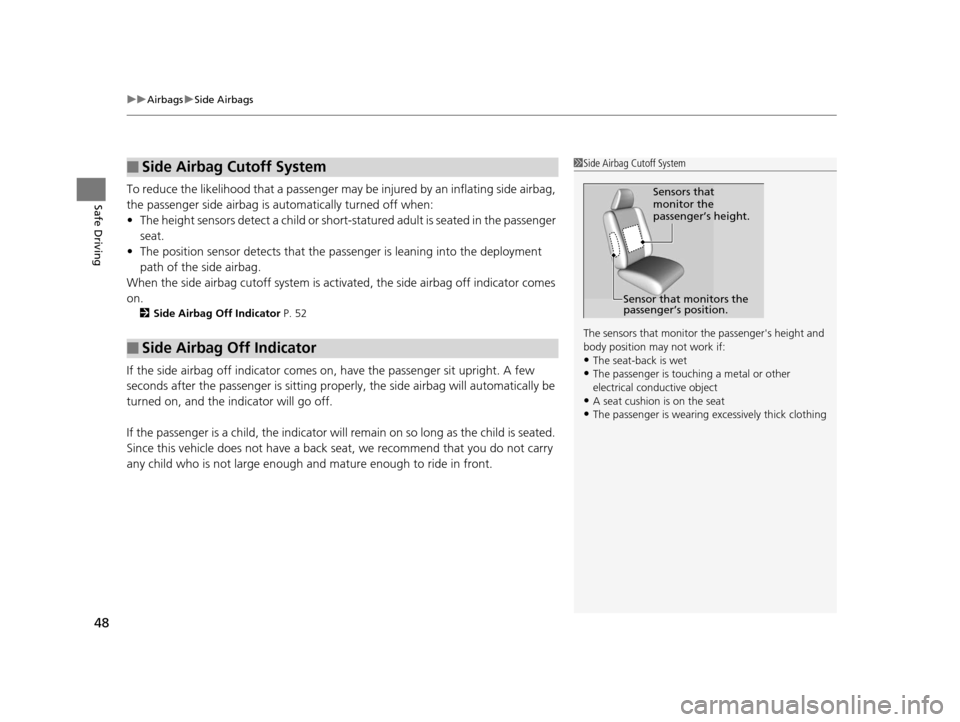
uuAirbags uSide Airbags
48
Safe DrivingTo reduce the likelihood that a passenger may be injured by an inflating side airbag,
the passenger side airbag is automatically turned off when:
• The height sensors detect a child or short- statured adult is seated in the passenger
seat.
• The position sensor detects that the passenger is leaning into the deployment
path of the side airbag.
When the side airbag cutoff system is acti vated, the side airbag off indicator comes
on.
2 Side Airbag Off Indicator P. 52
If the side airbag off indicator comes on, have the passenger sit upright. A few
seconds after the passenger is sitting properly, the side airbag will automatically be
turned on, and the indicator will go off.
If the passenger is a child, the indicator will remain on so long as the child is seated.
Since this vehicle does not have a back seat, we recommend that you do not carry
any child who is not large enough and mature enough to ride in front.
■Side Airbag Cutoff System
■Side Airbag Off Indicator
1 Side Airbag Cutoff System
The sensors that monitor the passenger's height and
body position may not work if:
•The seat-back is wet•The passenger is touc hing a metal or other
electrical conductive object
•A seat cushion is on the seat•The passenger is wearing excessively thick clothing
Sensors that
monitor the
passenger’s height.
Sensor that monitors the
passenger’s position.
15 CR-Z-31SZT6400.book 48 ページ 2014年8月1日 金曜日 午後1時59分
Page 52 of 329
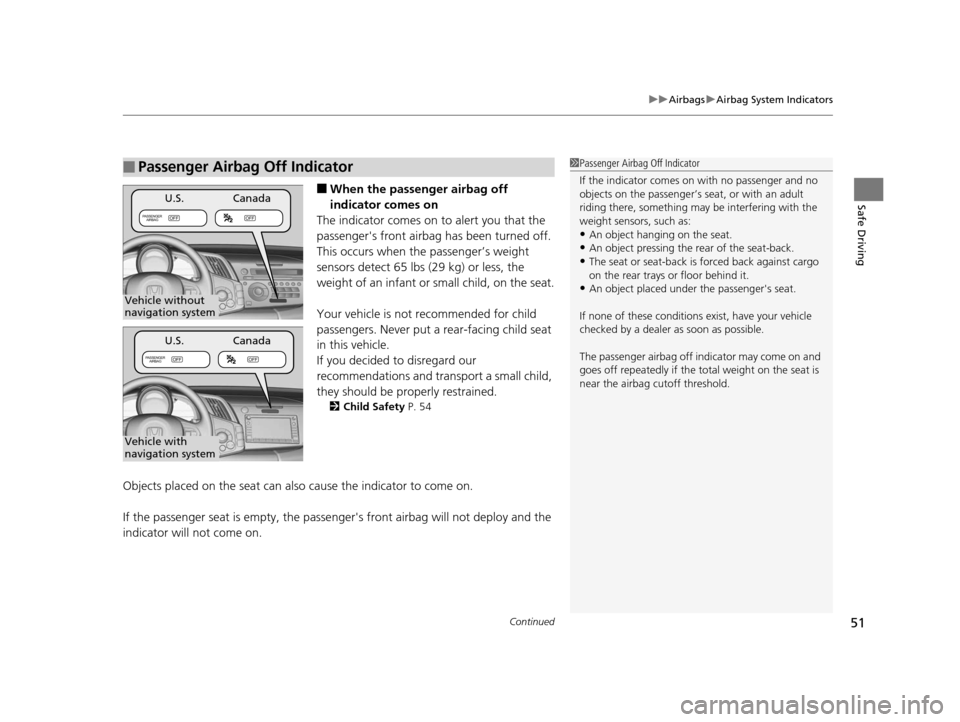
Continued51
uuAirbags uAirbag System Indicators
Safe Driving■When the passenger airbag off
indicator comes on
The indicator comes on to alert you that the
passenger's front airbag has been turned off.
This occurs when the passenger’s weight
sensors detect 65 lbs (29 kg) or less, the
weight of an infant or small child, on the seat.
Your vehicle is not recommended for child
passengers. Never put a rear-facing child seat
in this vehicle.
If you decided to disregard our
recommendations and tran sport a small child,
they should be properly restrained.
2 Child Safety P. 54
Objects placed on the seat can also cause the indicator to come on.
If the passenger seat is empty, the passe nger's front airbag will not deploy and the
indicator will not come on.
■Passenger Airbag Off Indicator1 Passenger Airbag Off Indicator
If the indicator comes on with no passenger and no
objects on the passenger’s seat, or with an adult
riding there, something may be interfering with the
weight sensors, such as:
•An object hanging on the seat.
•An object pressing the rear of the seat-back.
•The seat or seat-back is forced back against cargo
on the rear trays or floor behind it.
•An object placed under the passenger's seat.
If none of these conditions exist, have your vehicle
checked by a dealer as soon as possible.
The passenger airbag off indicator may come on and
goes off repeatedly if the to tal weight on the seat is
near the airbag cutoff threshold.
OFFOFFPASSENGER AIRBAG
OFFOFFPASSENGERAIRBAG
Canada
U.S.
Canada
Vehicle without
navigation system
Vehicle with
navigation systemU.S.
15 CR-Z-31SZT6400.book 51 ページ 2014年8月1日 金曜日 午後1時59分